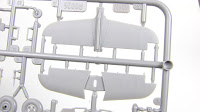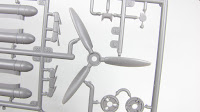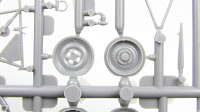1:48 Hurricane Mk IIc “Jubilee”

Arma Hobby celebrated its tenth anniversary with a special 1:48 scale kit dedicated to Hurricanes taking part in Operation Jubilee. Quite amusing, to be honest. Let's take a closer look.
Disclaimer
The review sample was kindly provided by the manufacturer. Thanks, Arma Hobby.
Overview
The set, with catalogue number 40006, catches the eye with a lovely artwork by Piotr Forkasiewicz.
It's content is additionally protected by a cardboard insert, which is the standard for larger boxes from AH.
As this is a special edition, in addition to the usual dose of plastic sprues (3 grey ones plus transparencies), masks, decals and instruction, we also get a bundle of 3D printed resin parts – enough for two models.
So one can enhance one of the previously released Hurricanes, which did not include such goodies (see review).
Grey plastic
Let's begin a more detailed inspection of the kit content with the fuselage, divided quite traditionally, lengthways into two halves.
With one exception. The underside of the tail section (with a quite nicely marked linen covering) was designed as a separate element and we get it in two variants, one of which is unused in this edition.
But let's go back to the earlier mentioned halves and take a closer look at the considerable amount of both raised and recessed surface details, which look quite decent, to say the least. One small downside is the area around the little fairings located on either side of the engine, on the horizontal panel line behind the exhausts.
Both the rudder and elevator were designed as a separate pieces, glued to their respective stabilisers.
Two spinners are provided for the three-blade propeller and the assembly's mounting method allows it to remain mobile.
Exhausts are another multi-variant component, with two sets available on the sprues. They don't look the best, but it doesn’t really matter this time – there are resin alternatives included.
Let's return to the fuselage halves one last time, to take a peek at the inner surfaces of the cockpit sides, which are enhanced by a number of small equipment details (parts 32-36).
The space in between is to be filled with quite nice looking main structural elements.
The control column (17-19) and the rudder pedals (21, 22) don’t look bad either.
The pilot's seat (25-28) is another element, which can be replaced with resin print.
The instrument panel (29) with compass (30) looks quite nice.
Let's move on to the wings, which are in my opinion the most interesting part of the kit. This is because both the upper and lower surfaces have been showered with a whole bunch of different details. Of particular note are the rivets, featured both in raised and recessed form. This mimics the variation of such joints present on the real machine, where flush rivets were used on the surfaces with the greatest influence on the airframe's aerodynamics (e.g. wings’ leading edge), and standard mushroom-headed ones on the remaining surfaces. It should also be noted that the raised rivets and bolts come in several sizes.
Cut-outs in the leading edge of the wing were prepared for the installation of cannons (more on that later) and landing lights (parts 47 and 48 plus glazing).
Meanwhile the underside features slots for easy installation of the oil cooler (5, 7 and unlabelled part 6) along with its housing (3, 4, 8).
Nearby are attachment points for the carburettor air intake (14-15). The tropical filter version (28, 29), also present on the sprues, won't be used this time.
Structural elements of the main landing gear bay also got a dose of varied surface details.
Raised rivets can also be found on the fairings, and the two-piece wheels are notable for the inscriptions on the tyres' sidewalls.
The latter can also be spotted on the tailwheel, the assembly of which was prepared in two versions.
The miniature's guns, in the form of four wing cannons, comes in two variants too. Resin replacements were provided for both.
Plastic sprues also include parts for making the under-wing bombs along with the racks, but none of the box painting options requires them.
Alternatively, additional fuel tanks are available (for one machine). In both cases the appropriate mounting holes must be drilled in the lower part of the wings (marked on the inside), as the instructions indicate in advance.
Finally, let's take a look at a handful of minor details such as the aerial mast (58), the pitot tube (57), exhaust glare shields (59, 60), and the retractable entry footstep (50).
The last one should be only installed if the handhold behind the cockpit was left open.
Resin prints
A real treat are the printed resin parts included in the kit. Two versions of exhausts, two types of cannons and two pilot's seats with belts. It is impossible to cram all this into one model – which leaves us with a set to upgrade a second Hurricane.
Unfortunately not everything is fine and dandy here.
The barrels, at least in my case, are slightly curved.
Transparent plastic
The transparent sprue is filled mostly by canopy elements of a very good transparency and definitely acceptable thickness.
The windscreen is complemented by backward-sliding part in two variants – depending on whether you want to install it in the open or closed position.
One will find here also a handful of minor details such as glass for landing lights and the rear-view mirror.
Two types of the latter provided – round one and rectangular.
Masks
The included masks, cut in the familiar and well-liked yellow adhesive paper, will help with painting the canopy.
This time the manual point out which batch of stickers is for a closed cockpit option and which for an open one.
Decals
The markings prepared in the form of decals are a collaboration between the model manufacturer and Techmod.
As usual, this means a quality print with not much to complain about.
Stencils and instrument panel looks nice and clear.
Seatbelts not so much.
Fortunately, you don't have to use those, there is a resin seat after all.
Manual
The booklet with step-by-step instructions on building the model is typical for AH. Clear and easy to follow assembly drawings sprinkled here and there with additional comments.
Suggested paint colours listed in a table.
Paint schemes, as usual in colour, with decal placement directions.
Usual stuff.
Markings
With included decals one can make a miniature in one of three painting options, traditionally hinted on the back of the box. To quote the manufacturer, those are.
Hurricane Mk.IIc BE500/LK-A. No. 87 Squadron RAF. Tangmere airfield. Three missions in operation “Jubilee”. Pilots: S/Ldr D.G. Smallwood i F/L A.H. Thom.
Hurricane Mk.IIc Z3081/FT-V “Baron Dhanis”. No. 43 Squadron RAF. Tangmere airfield. Three missions in operation “Jubilee”. Pilot S/Ldr D.A.R.G. Le Roy du Vivier (Belgium).
Hurricane Mk.IIC BD867/QO-Y, No. 3 Squadron RAF, Hunsdon airfield, Autumn 1941. This aeroplane was shot down during the “Jubilee” operation, pilot Sgt. Stirling David Banks (RCAF) died. The appearance and marking of this plane on 19th August 1942 is unknown.
Despite the thematic limitation imposed, a relatively diverse selection.
Summary
While covering previous editions of this model, I was able to complain about the weak plastic exhausts or the decal-only seatbelts. The resin parts included in the “jubilee” edition took that away from me and the whole thing looks very good to say the least.
I can only congratulate the 10-year anniversary and look forward to more excellent model kits.
Live long and prosper Arma Hobby.











































































































